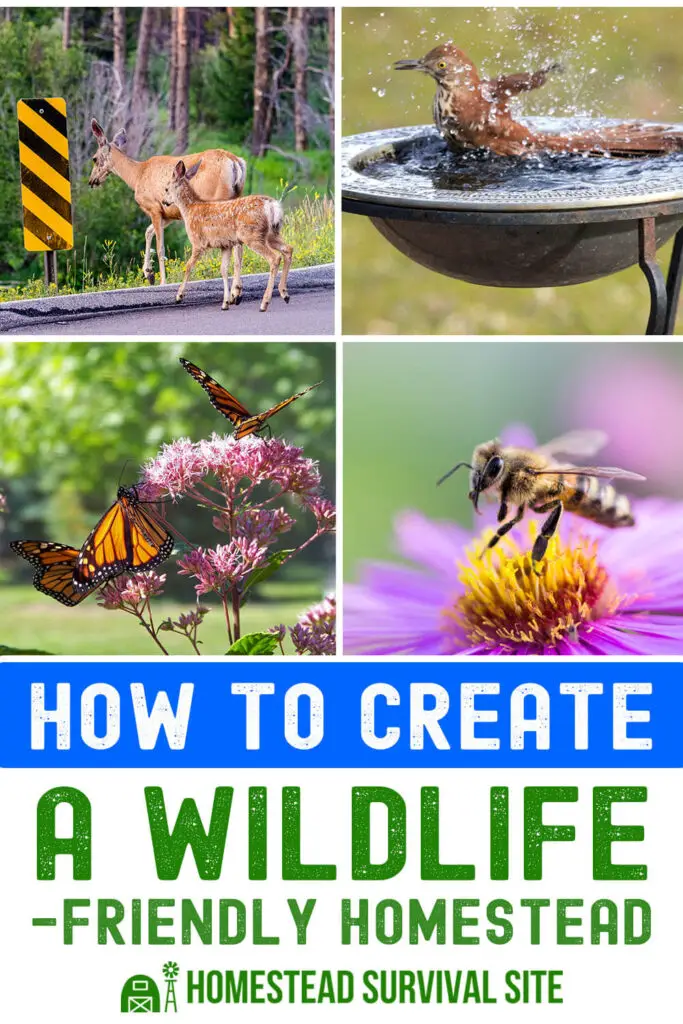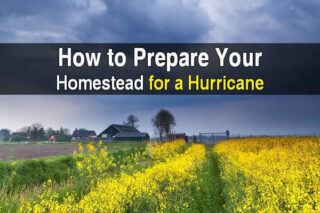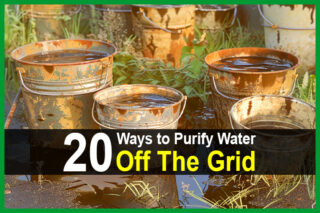Estimated reading time: 10 minutes
For many of us, the last thing we want in our yards and gardens is unwelcome visitors. This includes animals like rabbits, squirrels, insects and anything that feeds on or infects our plants or threatens our pets.
However, there is an approach that embraces wildlife (to some degree) and strives to create an environment that balances wildlife with a habitat that is still under some degree of control.
How far you take this has a lot to do with your location and your inclination. It can also be a gradual effort that you advance over the seasons until you feel you have the right balance.
Want to save this post for later? Click Here to Pin It On Pinterest!
Defining Wildlife
This isn’t about inviting coyotes, bears, and feral dogs onto our property. It’s more about birds, bees, fairly gentle creatures like possums, raccoons, squirrels, and yes – even rabbits. It’s all a question of managing some of the wildlife while creating an environment that not only invites them in, but allows them to thrive.
Surprising Benefits
Wildlife can actually create a healthier environment around your home and homestead.
- Birds feed on insects that could be harming your plants and often fill the area with song.
- Bees pollinate both flowers and vegetables and especially fruit trees and vines.
- Possums eat slugs, snails, grasshoppers and other insects that can devastate flowers, fruits, and vegetables.
- Butterflies are also active pollinators that can often get to those blossoms that bees might miss.
- Even snakes, raccoons, and other active but small predators can keep the mice out of the house and outbuildings.
It’s Not About Total Surrender
It makes sense to keep a fence around vegetables, a circle of wire around the base of young fruit trees, and many homesteads need an enclosure for livestock. Not all wildlife is beneficial and rabbits are indiscriminate when it comes to eating most anything that grows.
The key is to manage the barriers.
Things to Stop Doing
• Fence only where you need it
We already mentioned vegetable gardens and livestock pens, but a perimeter fence around your property is a big stop sign for wildlife. If security in your location is an issue, you’ll need the fence, but if it’s not necessary – skip it.
• Reduce the size of your lawn
Flat, mowed turf is not an inviting biome for wildlife. For one, it’s a food desert. No easily edible plants, no flowers or blossoms, just flat grass. For another, it’s a very open environment. Most animals prefer cover to give them some protection from predators. A large and open lawn area is a no-man’s land for most wildlife.
• Avoid using pesticides, herbicides, fungicides and other chemicals
It’s easy to fertilize with chemical fertilizers and just as easy to spray fruit trees and vegetables with chemical pesticides. That’s a bad idea if you want to attract pollinators or create a safe environment for wild animals. It’s also going to be better for you, your kids, and especially pets.
• Think about noise management
This is easier said than done. We all have to use equipment from time to time, but if there’s something on the property that consistently makes noise, see if you can minimize it or stop it. A squeaky windmill or even loud music comes to mind. Nature tends to be quiet most of the time. See what you can do to keep the noise down.
• Do you really need those bright lights?
Many animals are nocturnal and if you fill the night with light, they’ll shy away. Use lights with motion detectors if you can, or shut the light off if you don’t need it on for some reason. Then again, if you have a problem with some animal approaching at night, leave them on.
• Don’t prune so much
Some trees and plants need to be pruned, but don’t overdo it. Wildlife likes cover, and highly pruned trees, shrubs, and bushes provide less cover. Pruning can be a good idea, but know when to stop.
Things to Start Doing
√ Create a water source
All animals and insects need water. Think about digging a small pond, creating a fountain, or running a pumped waterfall into your pond. If a pond is out of the question, you could put a few bird baths around. But don’t depend on bird baths alone. Create small water sources at various levels including ground level. Most animals can’t fly up to a birdbath.
If you have a pond with still water, you might want to add some small fish to feed on mosquito larvae. Goldfish are hardy, but even a few bluegills will do the trick.
√ Plant to attract pollinators
This is about attracting bees, butterflies, and even hummingbirds. They all act as pollinators and will help you increase the yield from any garden or fruit trees.
√ Let it grow wild
This gets back to reducing lawn size. You don’t have to turn a lot of the lawn into a new, high-maintenance garden. Just let it go wild. Eventually, wildflowers will start to fill in and you could even toss some millet or quinoa seeds around to attract more birds. You could also harvest some for yourself.
√ Get some bird feeders
You can buy a variety of bird feeders or build your own. You could also buy wild bird seed or grow your own. The thing to think about is choosing the right type of seeds. Certain seeds attract certain birds. Some birds are nice to look at; others fill the yard with their songs, and most prey on harmful insects.
√ Build birdhouses
You could also buy them, but birdhouses are easy to build and will keep them coming back season after season. Birds born in a yard or property will often stay in the vicinity.
Owl boxes are another idea and are the best mouse and rat patrol you can have on your property.
√ Let it Rot
This sounds weird, but rotting logs, bark, and even leaves attract insects that feed wildlife. You probably don’t want to do this next to the house, but if you have a large piece of property, don’t get too ambitious about cleaning up every square foot. Keep it natural and sometimes, just let it rot.
√ Compost
Composting is the most natural way to return nutrients to any garden, and it’s easy to do. It also creates a great biome for insects, particularly worms.
If you want, take it up a notch and toss some redworms into your compost heap to engage in some vermiculture. The worm castings are super compost and will add to the overall health of your gardens everywhere you put it.
√ Plant a variety of grasses and greens
These types of plants will provide plenty of food for wildlife, and most grasses will eventually produce seeds for the wild birds. Native plants are best not only because they will grow well in your area, but because the local wildlife is familiar with it. And while you’re at it, it might be a good idea to plant some milkweed out on the perimeter of your property.
Monarch butterflies are 100% dependent on milkweed to survive, and there is a nationwide effort to eradicate milkweed. The result has been an alarming decline in the Monarch butterfly population. Do them a favor and plant some milkweed
- Beyond Flowers: Enhancing Wildlife Gardens with Native Grasses
- 24 Native Plants to Create a Buzzing Backyard Sanctuary in 2024
- When, where and how to plant milkweed to save the monarch butterfly
√ Trees, trees, trees
Trees not only provide shade and cover but are a destination for birds. Think about fruit trees or nut trees that can not only feed wildlife but you, too. Other trees to consider are oaks for furniture and firewood, maples for maple syrup, or pines for just as many benefits. The key is to plant trees that benefit you and the wildlife you’re trying to attract and sustain.
Some Things to Think About
• Dogs and Cats
Many of us love dogs and cats and consider them part of the family. The fact is pets like dogs and cats can be a deterrent to wildlife. A lot depends on the size of your property.
It’s ridiculous to expect anyone to give up their dog or cat for the sake of some random wild animals, but if you have a pet, it may diminish the amount of wildlife attracted to your property. Then again, birds and bees don’t seem to pay a whole lot of attention.
• Detrimental wildlife
There’s always a catch. Any effort to naturalize an area to attract wildlife can have some unintended consequences. This could include a gang of coyotes who make your property a new destination, or a warren of rabbits who decided to be fruitful and multiply.
The only options are to step back from naturalizing your yard, put up some fences in areas where you need to keep them out, or find other steps or measures to improve the neighborhood. The family dog can help with the rabbits, but the last thing you want is for your dog to encounter a pack of coyotes.
A lot of this depends on your location and what part of the country you live in. If you have dangerous or detrimental wildlife around you, you’re probably already aware of it and know what steps you need to take. This is especially true in areas with bears or venomous snakes that can go beyond a nuisance to life-threatening.
- How to Survive a Bear Attack
- Using Vinegar To Repel Coyotes: A Simple And Natural Solution
- Natural Snake Repellent
• When Wasps and Hornets show up with the Bees
Wasps and hornets are pollinators too, along with a variety of other stinging, flying insects. Rather than return to a distant hive or nest, many stinging insects will set up shop on your property. Paper wasps are one example, and they are quick to sting when disturbed.
The only solution is to break your own rules and spray them or find another way to take down the nest and discourage their presence. These types of insects can show up regardless of how natural or inviting your yard may be, but when you’re actively trying to attract wildlife, you may get some unwanted guests.
Take Your Time
How ambitious you get with this kind of activity has a lot to do with the size of your property and your desire to naturalize the environment to invite wildlife. The best approach may be to research the subject, go slow, take your time, and assess your results.
Some of the solutions and approaches are easy, like planting flowers and fruits that attract pollinators. Others take a bit of time, but nature is patient. The only thing that matters is that you and your family are pleased with the results and enjoy your yard and property more than before.
Like this post? Don't Forget to Pin It On Pinterest!
You May Also Like:












What you are describing is similar to permaculture, or a food forest. I had my dead ash and pine trees turned into biochar or mulch and using some for water retention on hills, Im replacing tag alders with service and aronia berry bushes. Much to be done here. I’ve just got started.